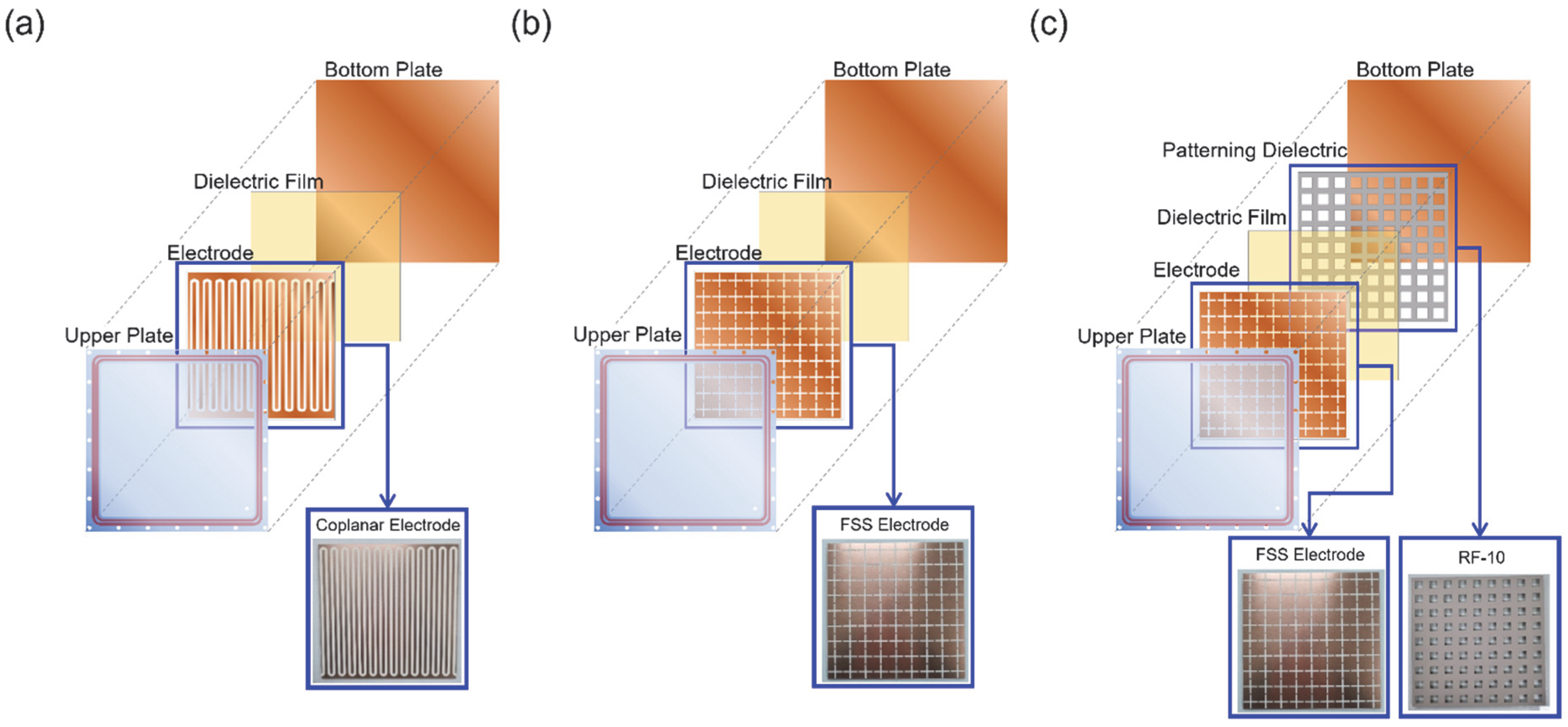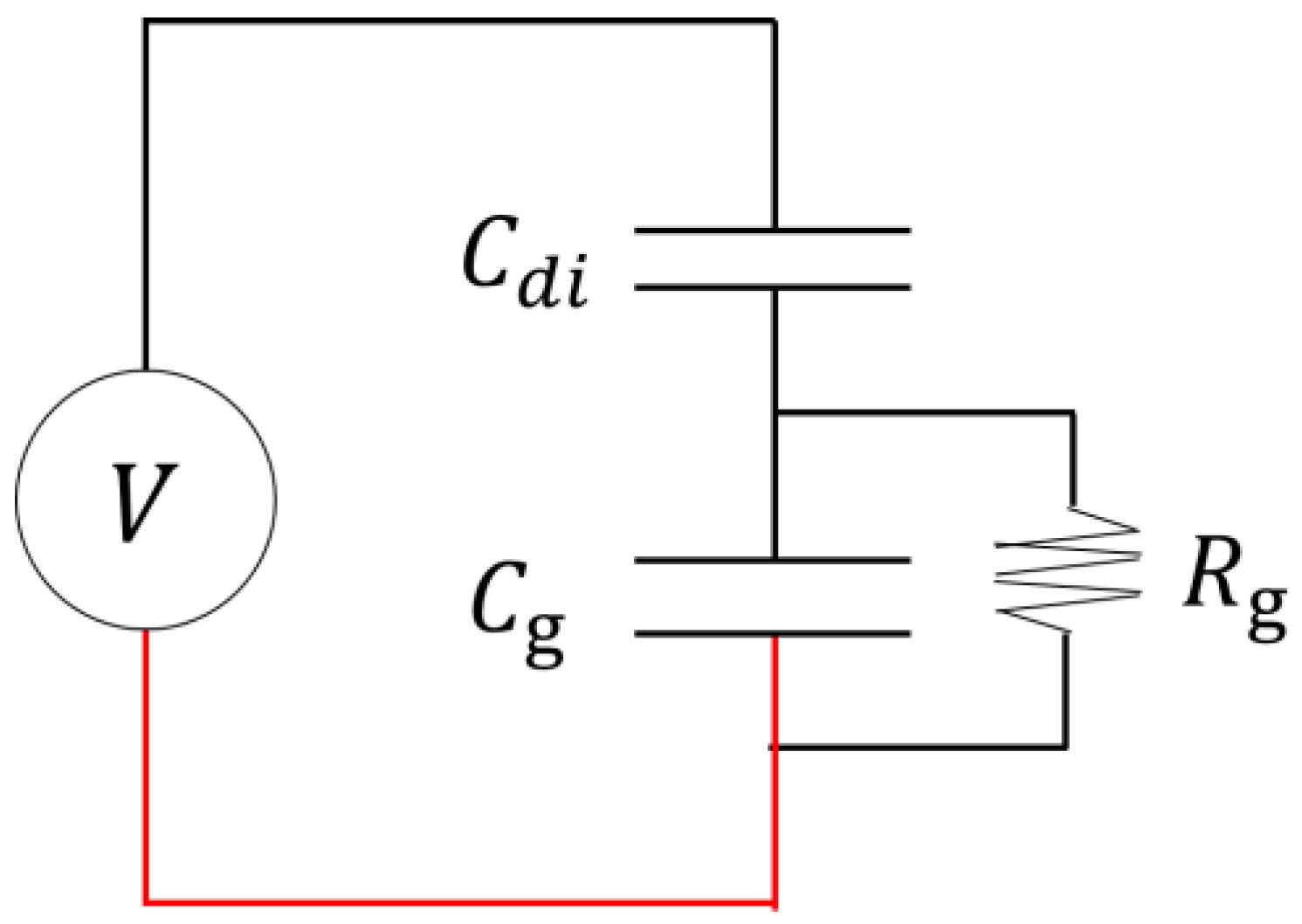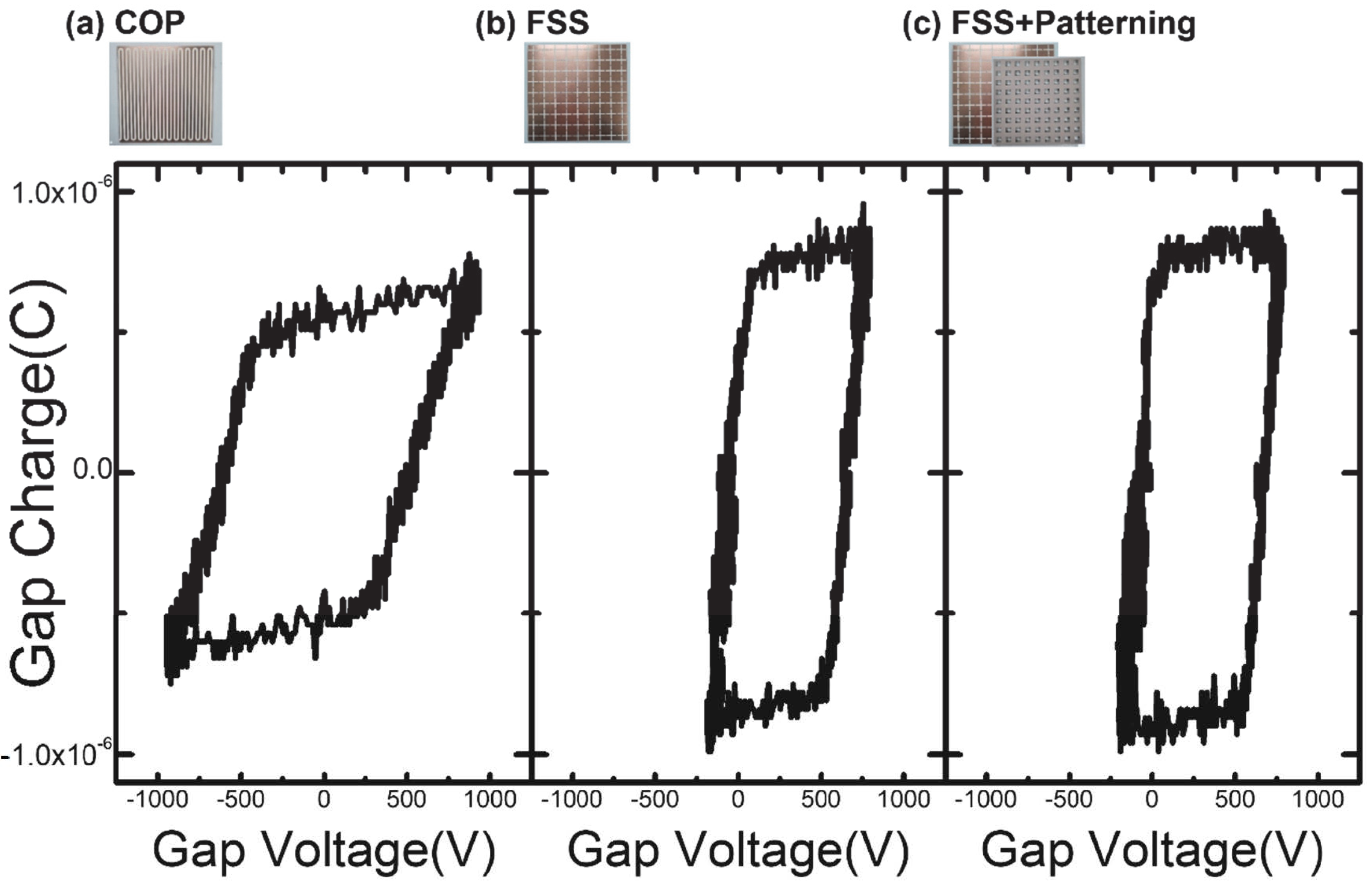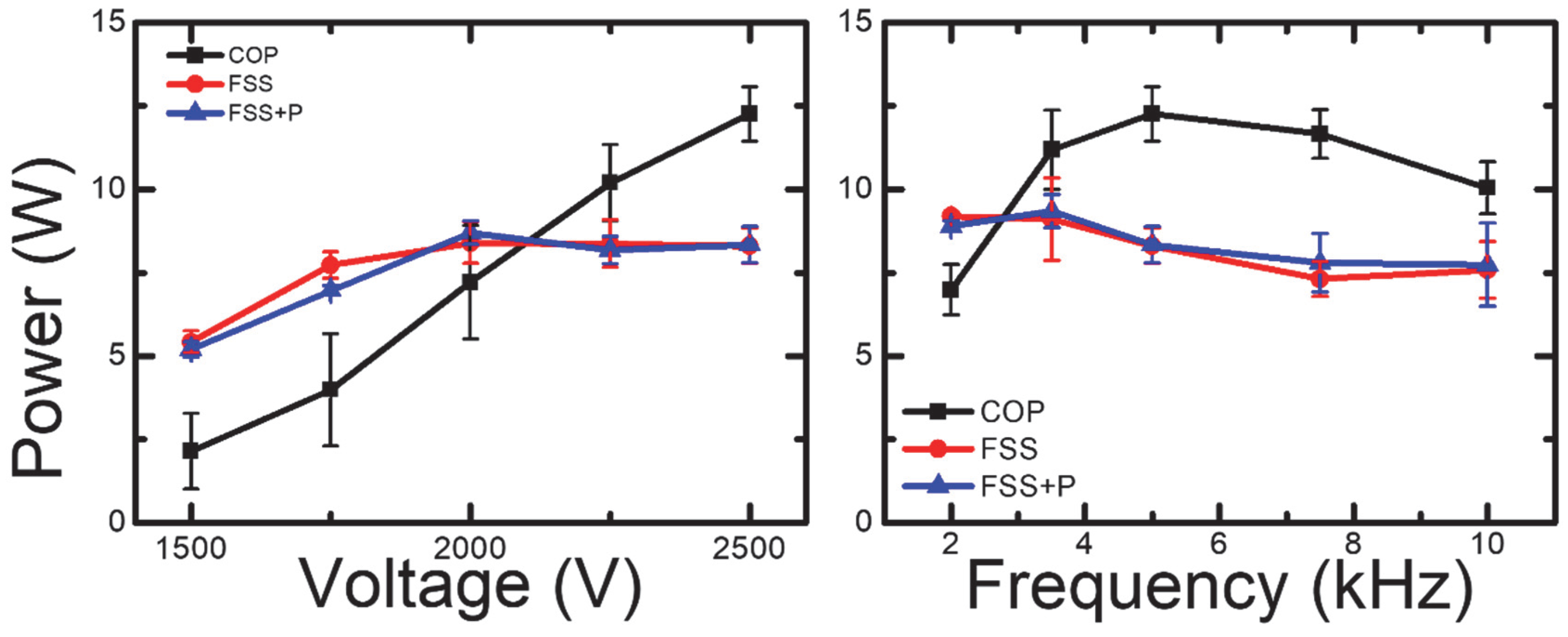On Encapsulated Dielectric Barrier Discharge Plasma Sources for Radar Cross Section Reduction in Mobile Environments
Abstract
:1. Introduction
2. Materials and Methods
- (a)
- DBD source structure and discharge characteristics
- (b)
- DBD source voltage measurement
- (c)
- Methods
3. Results and Discussion
4. Conclusions
Author Contributions
Funding
Data Availability Statement
Conflicts of Interest
References
- Ghayekhloo, A.; Afsahi, M.; Orouji, A.A. Checkerboard Plasma Electromagnetic Surface for Wideband and Wide-Angle Bistatic Radar Cross Section Reduction. IEEE Trans. Plasma Sci. 2017, 45, 603–609. [Google Scholar] [CrossRef]
- Cross, L.W. Study of X-Band Plasma Devices for Shielding Applications. In Proceedings of the 2014 IEEE MTT-S International Microwave Symposium (IMS2014), Tampa, FL, USA, 1–6 June 2014. [Google Scholar]
- Payne, K.; Xu, K.; Choi, J.H.; Lee, J.K. Electrically Tunable Microwave Absorber Based on Discrete Plasma-Shells. IEEE Trans. Plasma Sci. 2019, 67, 6523–6531. [Google Scholar] [CrossRef]
- Ebrahimi, E.H.; Sohbatzadeh, F.; Zakeri-Khatir, H. The influence of electrical waveform on the electron density and collision frequency of low-pressure gas discharge plasma. J. Phys. D Appl. Phys. 2019, 53, 034001. [Google Scholar] [CrossRef]
- Ebrahimi, E.H.; Sohbatzadeh, F.; Zakeri-Khatir, H. Radar cross -section reduction by tunable low-pressure gas discharge plasma. J. Phys. D Appl. Phys. 2020, 53, 325202. [Google Scholar] [CrossRef]
- He, X.; Chen, J.; Zhang, Y.; Chen, Y.; Zeng, X.; Tang, C. Numerical and Experimental Investigation on Electromagnetic Attenuation by Semi-Ellipsoidal Shaped Plasma. Plasma Sci. Technol. 2015, 17, 869. [Google Scholar] [CrossRef]
- He, X.; Zhang, Y.; Chen, J.; Chen, Y.; Zeng, X.; Yao, H.; Tang, C. Experimental investigation on electromagnetic attenuation by low pressure radio-frequency plasma for cavity structure. Plasma Sci. Technol. 2016, 18, 62. [Google Scholar] [CrossRef]
- Zhang, Y.; He, X.; Chen, J.; Chen, L.; Zhang, H.; Ni, X.; Lu, J.; Shen, Z. Broadband microwave absorption and standing wave effect in helium capacitively coupled plasma. Phys. Plasmas 2017, 24, 083511. [Google Scholar] [CrossRef]
- Zainud-Deen, S.H.; Malhat, H.; Shabayek, N.A. Reconfigurable RCS Reduction from Curved Structures Using Plasma Based FSS. Plasmonics 2020, 15, 341–350. [Google Scholar] [CrossRef]
- Malhat, H.; Zainud-Deen, S.H.; Shabayek, N.A. RCS Reduction from Conformal Surfaces Using Plasma-Based AMC Arrays. Plasmonics 2020, 15, 1025–1033. [Google Scholar] [CrossRef]
- Malhat, H.; Zainud-Deen, A.S.; Badawy, M.M. Reconfigurable chessboard coding plasma based dielectric resonator structure for RCS reduction. Opt. Quantum Electron. 2023, 55, 369. [Google Scholar] [CrossRef]
- Ha, J.H. Study Discharge Character of DBD (Dielectric Barrier Discharge). Ph.D. Thesis, Kookmin University, Seoul, Republic of Korea, 2005. [Google Scholar]
- Lee, J.J.; Kim, S.J.; Lee, Y.S.; Cho, C.H.; Choi, M.S.; Seong, I.H.; Lee, S.H.; Jeong, W.N.; You, S.J. Experimental Study of Argon and Helium Dielectric Barrier Discharge with Coplanar Electrodes at Intermediate Pressure for Reducing Radar Cross Section. Appl. Sci. Converg. Technol. 2020, 29, 170–175. [Google Scholar] [CrossRef]
- Cho, C.; Oh, T.; Ahn, W.; Yook, J.; Lee, J.; You, S.; Yim, J.; Ha, J.; Bae, G.; You, H.; et al. Coplanar Dielectric-Barrier-Discharge (DBD) Plasma Generator for X-Band Radar Cross Section (RCS) Reduction. J. Korean Inst. Electromagn. Eng. Sci. 2021, 32, 1091–1098. [Google Scholar] [CrossRef]
- Oh, T.; Cho, C.; Ahn, W.; Yook, J.; Lee, J.; You, S.; Yim, J.; Ha, J.; Bae, G.; You, H.; et al. Plasma Generator with Dielectric Rim and FSS Electrode for Enhanced RCS Reduction Effect. Sensors 2021, 21, 8486. [Google Scholar] [CrossRef] [PubMed]
- Jeong, J.; Cho, C.; Choi, M.; You, S.; Yim, J.; Ha, J.; Lee, Y. Improved Estimation Method for Effect of DBD (Dielectric Barrier Discharge) Plasma on RCS (Radar Cross Section) Reduction. In Proceedings of the 2023 International Conference on Electronics, Information, and Communication (ICEIC), Singapore, 5–8 February 2023. [Google Scholar]
- Kusumandari, K.; Saraswati, T.E.; Prakoso, A.D. The in situ DBD plasma for Remazol dyes based textile wastewater remediation. Int. J. Environ. Sci. Technol. 2022, 20, 4447–4458. [Google Scholar] [CrossRef]
- Corbella, C.; Portal, S.; Lin, L.; Keidar, M. Non-thermal plasma multi-jet platform based on a flexible matrix. Rev. Sci. Instrum. 2021, 92, 083505. [Google Scholar] [CrossRef]
- Lomaev, M.I. Determination of еnеrgу input in barrier discharge excilamps. Atrnos. Oceanic Opt. 2001, 14, 1005–1008. [Google Scholar]
- Falkenstein, Z.; Coogan, J.J. Microdischarge behaviour in the silent discharge of nitrogen–oxygen and water–air mixtures. J. Phys. D Appl. Phys. 1997, 30, 817–825. [Google Scholar] [CrossRef]
- Liu, S.; Neiger, M. Excitation of dielectric barrier discharges by unipolar submicrosecond square pulses. J. Phys. D Appl. Phys. 2001, 34, 1632–1638. [Google Scholar] [CrossRef]
- Pipa, A.V.; Koskulics, J.; Brandenburg, R.; Hoder, T. The simplest equivalent circuit of a pulsed dielectric barrier discharge and the determination of the gas gap charge transfer. Rev. Sci. Instrum. 2012, 83, 115112. [Google Scholar] [CrossRef]
- Wang, Y.; Yuan, C.; Zhou, Z.; Li, L.; Du, Y. Propagation of Gaussian laser beam in cold plasma of drude model. Phys. Plasmas 2011, 18, 113105. [Google Scholar] [CrossRef]
- Kolner, B.H.; Buckles, R.A.; Conklin, P.M.; Scott, R.P. Plasma characterization with terahertz pulses. IEEE J. Sel. Top. Quantum Electron. 2008, 14, 505–512. [Google Scholar] [CrossRef]
- Godyak, V.A.; Piejak, R.B.; Alexandrovich, B.M. Electron energy distribution function measurements and plasma parameters in inductively coupled argon plasma. Plasma Sources Sci. Technol. 2002, 11, 525–543. [Google Scholar] [CrossRef]
- Godyak, V.A.; Alexandrovich, B.M. Comparative analyses of plasma probe diagnostics techniques. J. Appl. Phys. 2015, 118, 233302. [Google Scholar] [CrossRef]
- Wagner, H.-E.; Brandenburg, R.; Kozlov, K.V.; Sonnenfeld, A.; Michel, P.; Behnke, J.F. The barrier discharge: Basic properties and applications to surface treatment. Vacuum 2003, 71, 417–436. [Google Scholar] [CrossRef]
- Rueda, V.; Diez, R.; Bente, N.; Piquet, H. Combined Image Processing and Equivalent Circuit Approach for the Diagnostic of Atmospheric Pressure DBD. Appl. Sci. 2022, 12, 8009. [Google Scholar] [CrossRef]








Disclaimer/Publisher’s Note: The statements, opinions and data contained in all publications are solely those of the individual author(s) and contributor(s) and not of MDPI and/or the editor(s). MDPI and/or the editor(s) disclaim responsibility for any injury to people or property resulting from any ideas, methods, instructions or products referred to in the content. |
© 2023 by the authors. Licensee MDPI, Basel, Switzerland. This article is an open access article distributed under the terms and conditions of the Creative Commons Attribution (CC BY) license (https://creativecommons.org/licenses/by/4.0/).
Share and Cite
Choi, M.; You, S.-J.; Jung, J.; Cho, C.; Lee, Y.; Kim, C.; Ha, J.; Lee, H.; Seol, Y. On Encapsulated Dielectric Barrier Discharge Plasma Sources for Radar Cross Section Reduction in Mobile Environments. Sensors 2023, 23, 9170. https://doi.org/10.3390/s23229170
Choi M, You S-J, Jung J, Cho C, Lee Y, Kim C, Ha J, Lee H, Seol Y. On Encapsulated Dielectric Barrier Discharge Plasma Sources for Radar Cross Section Reduction in Mobile Environments. Sensors. 2023; 23(22):9170. https://doi.org/10.3390/s23229170
Chicago/Turabian StyleChoi, Minsu, Shin-Jae You, Jinwoo Jung, Changseok Cho, Yongshik Lee, Cheonyoung Kim, Jungje Ha, Hyunsoo Lee, and Youbin Seol. 2023. "On Encapsulated Dielectric Barrier Discharge Plasma Sources for Radar Cross Section Reduction in Mobile Environments" Sensors 23, no. 22: 9170. https://doi.org/10.3390/s23229170
APA StyleChoi, M., You, S.-J., Jung, J., Cho, C., Lee, Y., Kim, C., Ha, J., Lee, H., & Seol, Y. (2023). On Encapsulated Dielectric Barrier Discharge Plasma Sources for Radar Cross Section Reduction in Mobile Environments. Sensors, 23(22), 9170. https://doi.org/10.3390/s23229170





